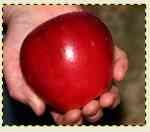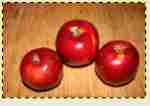
Tale of the Big Red Apple -
Daphne Ledward
A story for children of most ages (3-113)

Once upon a time......
when the world was young and petrol was cheap, a family went for a Sunday afternoon drive (well, they could afford to then).The little boy said, “I’m hungry, mummy.”
His mother said, “Have an apple, Tommy. Don’t eat anything else or you’ll spoil your tea.”
Tommy ate some of the apple, then said, “What do I do with this?” waving the remains at his mother, who said, “Give it here,” wound down the window and threw it onto the verge.
And Tommy and the rest of the family carried on with their afternoon drive, with no more thought as to the consequences of their actions, which is so often the case when people use the highway as a rubbish bin.
Now, you may say that this was a very untidy thing to do, and Tommy’s mummy should have been prosecuted for littering, as was recently suggested on a radio programme about discarded rubbish, but an apple core thrown onto a country verge can be considered somewhat different from a cigarette packet or the remains of a takeaway, and, children, I will now tell you why.
The remains of the apple rolled and bounced along the verge, and eventually came to rest in a tussock of rough grass bordering a ditch. A blackbird flew over, saw the tasty morsel, and ate all but the hard middle containing some plump, brown pips.
In time, the core rotted, the weather turned cold, the grass died back, and for a while the verge was covered in a blanket of snow.
Spring arrived, the sun grew stronger every day and suddenly a seedling appeared from where the core had rotted and the tussock had died down the previous autumn.
Because this part of the verge was so close to the ditch, it was never cut, so the seedling was left to grow unharmed. It forced its way through the thatch of dead grass and the canopy of new vegetation, turned its face to the sun and said, “Life is good here, I will make this place my home.”
As the years passed, the seedling grew into an apple tree. It was somewhat stunted because of neglect and the competition with the thick grass it had encountered, but it was a stocky youngster, albeit rather an odd shape because nobody had ever cared for it.
One spring it considered itself to be grown up, and produced some pale pink blossom followed by a few rather insignificant apples. As the years passed, the blossom became more plentiful and the yield much heavier, and eventually this little tree regularly produced a crop of bright red apples.
People driving past in early autumn would stop their cars and pick the fruit, which looked so juicy and delicious, only to spit it out in disgust as it was so sour. Eventually no-one bothered to take the apples, because everyone considered them uneatable.
One day the field the other side of the ditch was sold. The new owners discovered they had an unusual-looking apple tree on their verge, cleared out the rubbish from around the trunk, pruned the branches to give it a good shape, and waited to see what it would produce, only to discover, like everyone before them, that the fruit was so sour it made the eyes water.
For another twenty years the fruit would form, swell, ripen and drop off, and only the blackbirds appreciated it fully.
But it was an interesting tree, and a new, young specimen was grafted. Preserved for posterity, the apple was named the ‘Surfleet Sour’ from the area in which it was discovered, and the offspring was given a home in an arboretum on part of the field where it can receive every care and attention until old enough to crop.
Then the year came when the old tree produced a particularly good yield of large, striking apples. People would visit the field, spot the apples and gasp in amazement at the display. “You don’t want to eat those,” they were told, “they taste disgusting.”
However, after all the time that had elapsed since they last sampled the fruit, curiosity got the better of the owners of the field. Late in the autumn, just before Bonfire Night, they picked one big, bright red apple.
It was so beautiful.
They polished it to make it shine, they photographed it because it made such a pretty picture, they cut it in half to see if it still had the pale pink flesh underneath the skin they remembered, they cut a small sliver to taste - and it was delicious; sweet and juicy and far better than the apples they grew in their orchard.
Each year the tree had produced a late ripening crop, and everyone had been in too much of a hurry to try it.
So the moral of this tale is: if a first impression is unfavourable, it pays to wait and reconsider. You may be agreeably surprised.
Oh, and by the way, this story is not an excuse to throw all your rubbish out of the car, take it home and dispose of it properly.
 .....
.....
Reproduced by permission.